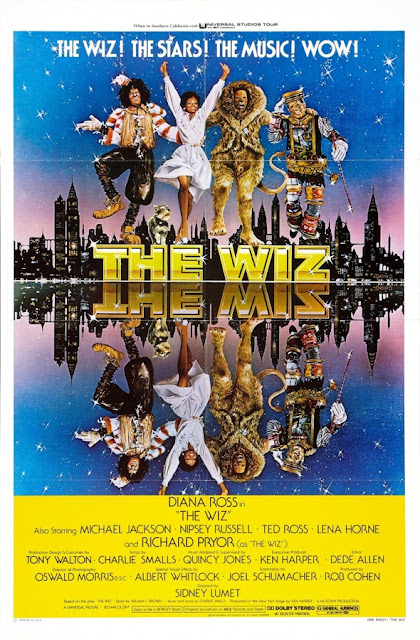Catering a new version of The Wizard of Oz to African-American
audiences was a novel idea—hence the success of the 1975 Broadway musical The Wiz, which combined funky songs and
an urban milieu to draw a parallel between L. Frank Baum’s timeless Oz stories and the longing for a better
life that’s experienced by many inner-city denizens. Yet one could argue that
generating an all-black show marginalized African-American culture as much as,
say, the lily-white casting of the beloved 1939 The Wizard of Oz movie. However, it’s probably best not to delve
into thorny racial politics here. Rather, the relevant question is whether The Wiz justifies its own existence in
purely aesthetic terms. Based on this lavish film adaptation (which, to be fair,
involved heavy changes to the source material), the answer is no. Dull, gloomy,
overwrought, and weighed down by Diana Ross’ ridiculous casting as a
fresh-faced youth, The Wiz is a chore
to watch.
Improbably, the film was directed by Sidney Lumet, best known for
making such gritty dramas as Dog Day
Afternoon (1975), though trivia buffs may dig noting that Lumet cast his
then-mother-in-law, singing legend Lena Horne, in a pivotal role. Anyway, the
basic story is familiar: Dorothy (Ross) gets transported to the magical land of
Oz, where she hooks up with companions for a trip down the Yellow Brick Road to
see the Wiz, whom she hopes can help her get home. You know the drill—wicked
witch, enchanted shoes, click your heels together, and so on. Every element is
tweaked with an African-American vibe, so in addition to all of the actors
being black, this movie’s version of Oz is a funhouse-mirror version of New
York, complete with subway stations and urban blight.
Ornately designed by Tony
Walton, who received two Oscar nominations for his work on the picture, The Wiz is a strange hybrid of chintzy
stagecraft and elaborate cinematic techniques—the costumes and sets in Oz look
deliberately bogus, and the big musical numbers unfold on a proscenium facing
the viewer. Therefore, notwithstanding screenwriter Joel Schumacher’s changes
to the play’s dialogue, this is less an adaptation of a stage show than a filmed
record of one. In a word, flat. Ross is awful on myriad levels, from being too
old for the role to over-singing her endless solo ballads—star ego run amok.
The supporting players generally try too hard, resulting in oppressive energy
and volume, though Michael Jackson (no surprise) stands out as the
loose-limbed, sweet-hearted Scarecrow. As for featured player Richard Pryor,
who plays the Wiz, he comes and goes so quickly that he can’t make an impact.
Whether the music works is of course a highly subjective matter, but to my
ears, only “Ease on Down the Road” (this film’s version of “Follow the Yellow Brick
Road”) and the Wicked Witch’s number, “Don’t Bring Me No Bad News,” linger—most
of the songs are gimmicky or syrupy, if not both. Yet the biggest problem with The Wiz—and there are lots of big problems—is that it’s not
fun. The dialogue is stilted, the mood is glum, the narrative drags, and the
production design is so artificial it can’t elicit any genuine reactions. If
ever, oh ever, a Wiz there was, this Wiz
ain’t it.
The Wiz:
LAME


1 comment:
Yep, I don't think it gets much lamer than this one. Unless you want to add a new rating called "beyond lame" ;-)
Post a Comment